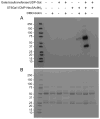Preparation of well-defined antibody-drug conjugates through glycan remodeling and strain-promoted azide-alkyne cycloadditions
- PMID: 24862406
- PMCID: PMC4128391
- DOI: 10.1002/anie.201402606
Preparation of well-defined antibody-drug conjugates through glycan remodeling and strain-promoted azide-alkyne cycloadditions
Abstract
Antibody-drug conjugates hold considerable promise as anticancer agents, however, producing them remains a challenge and there is a need for mild, broadly applicable, site-specific conjugation methods that yield homogenous products. It was envisaged that enzymatic remodeling of the oligosaccharides of an antibody would enable the introduction of reactive groups that can be exploited for the site-specific attachment of cytotoxic drugs. This is based on the observation that glycosyltransferases often tolerate chemical modifications in their sugar nucleotide substrates, thus allowing the installation of reactive functionalities. An azide was incorporated because this functional group is virtually absent in biological systems and can be reacted by strain-promoted alkyne-azide cycloaddition. This method, which does not require genetic engineering, was used to produce an anti-CD22 antibody modified with doxorubicin to selectively target and kill lymphoma cells.
Keywords: antibodies; click chemistry; glycan remodeling; glycosyltransferases; sialic acid.
© 2014 WILEY-VCH Verlag GmbH & Co. KGaA, Weinheim.
Figures




Similar articles
-
Efficient and Site-specific Antibody Labeling by Strain-promoted Azide-alkyne Cycloaddition.J Vis Exp. 2016 Dec 23;(118):54922. doi: 10.3791/54922. J Vis Exp. 2016. PMID: 28060353 Free PMC article.
-
Fast RNA conjugations on solid phase by strain-promoted cycloadditions.Org Biomol Chem. 2012 Sep 7;10(33):6633-9. doi: 10.1039/c2ob25628b. Epub 2012 Jul 2. Org Biomol Chem. 2012. PMID: 22751955
-
Reliable and efficient procedures for the conjugation of biomolecules through Huisgen azide-alkyne cycloadditions.Angew Chem Int Ed Engl. 2011 Sep 12;50(38):8794-804. doi: 10.1002/anie.201101019. Epub 2011 Aug 17. Angew Chem Int Ed Engl. 2011. PMID: 21905176 Review.
-
Strain-promoted alkyne-azide cycloadditions (SPAAC) reveal new features of glycoconjugate biosynthesis.Chembiochem. 2011 Aug 16;12(12):1912-21. doi: 10.1002/cbic.201100117. Epub 2011 Jun 9. Chembiochem. 2011. PMID: 21661087 Free PMC article.
-
Electrophilic Azides for Materials Synthesis and Chemical Biology.Acc Chem Res. 2020 Apr 21;53(4):937-948. doi: 10.1021/acs.accounts.0c00046. Epub 2020 Mar 24. Acc Chem Res. 2020. PMID: 32207916 Review.
Cited by
-
Dextramabs: A Novel Format of Antibody-Drug Conjugates Featuring a Multivalent Polysaccharide Scaffold.ChemistryOpen. 2019 Mar 28;8(3):354-357. doi: 10.1002/open.201900066. eCollection 2019 Mar. ChemistryOpen. 2019. PMID: 30976476 Free PMC article.
-
Enabling the formation of native mAb, Fab' and Fc-conjugates using a bis-disulfide bridging reagent to achieve tunable payload-to-antibody ratios (PARs).Chem Sci. 2023 Mar 9;14(14):3752-3762. doi: 10.1039/d2sc06318b. eCollection 2023 Apr 5. Chem Sci. 2023. PMID: 37035695 Free PMC article.
-
Oligosaccharide Synthesis and Translational Innovation.J Am Chem Soc. 2019 Mar 6;141(9):3735-3754. doi: 10.1021/jacs.8b11005. Epub 2019 Feb 18. J Am Chem Soc. 2019. PMID: 30716271 Free PMC article. Review.
-
Construction of homogeneous antibody-drug conjugates using site-selective protein chemistry.Chem Sci. 2016 May 1;7(5):2954-2963. doi: 10.1039/c6sc00170j. Epub 2016 Feb 12. Chem Sci. 2016. PMID: 29997785 Free PMC article. Review.
-
Structurally Defined αMHC-II Nanobody-Drug Conjugates: A Therapeutic and Imaging System for B-Cell Lymphoma.Angew Chem Int Ed Engl. 2016 Feb 12;55(7):2416-20. doi: 10.1002/anie.201509432. Epub 2016 Jan 14. Angew Chem Int Ed Engl. 2016. PMID: 26840214 Free PMC article.
References
-
- Ducry L, Stump B. Bioconjug Chem. 2010;21:5–13. - PubMed
-
- Zolot RS, Basu S, Million RP. Nat Rev Drug Discov. 2013;12:259–260. - PubMed
-
- Junutula JR, Raab H, Clark S, Bhakta S, Leipold DD, Weir S, Chen Y, Simpson M, Tsai SP, Dennis MS, Lu Y, Meng YG, Ng C, Yang J, Lee CC, Duenas E, Gorrell J, Katta V, Kim A, McDorman K, Flagella K, Venook RS, Spencer SD, Lee Wong W, Lowman HB, Vandlen R, Sliwkowski MX, Scheller RH, Polakis P, Mallet W. Nat Biotechnol. 2008;26:925–932. - PubMed
-
- Hutchins BM, Kazane SA, Staflin K, Forsyth JS, Felding-Habermann B, Schultz PG, Smider VV. J Mol Biol. 2011;406:595–603. - PMC - PubMed
- Axup JY, Bajjuri KM, Ritland M, Hutchins BM, Kim CH, Kazane SA, Halder R, Forsyth JS, Santidrian AF, Stafin K, Lu Y, Tran H, Seller AJ, Biroc SL, Szydlik A, Pinkstaff JK, Tian F, Sinha SC, Felding-Habermann B, Smider VV, Schultz PG. Proc Natl Acad Sci U S A. 2012;109:16101–16106. - PMC - PubMed
Publication types
MeSH terms
Substances
Grants and funding
LinkOut - more resources
Full Text Sources
Other Literature Sources

